Check out the other great projects there!
Here is a photo of one of the plant labels that I made for the gardens at the local shelter. I know I know there is no rhubarb in the pic. I just stuck it in my garden and took a picture to show you! I made 26 total.
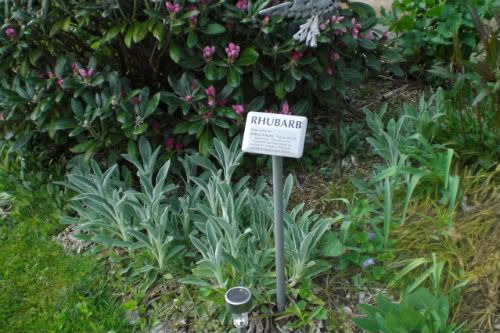
Today, Part One: the signs.
Tomorrow Part Two: the letters, and some variations on the theme.
Disclaimer: This project is experimental in that I haven't tested it in my garden for a full years weather. I have experience making things that stay out in the garden all year and have used that knowledge to design these. But only time will really tell.
My Charge: To find attractive plant labels with room to write educational information.
Why I chose this style: 1) Relatively inexpensive, large, good looking plant markers don’t exist to purchase. 2) There are testimonials that Avery LASER printed (not inkjet) labels last for many years in the garden through northern winter conditions. 3) Pieces of metal such as stainless steel or aluminium tags are expensive. 4) I have a cutting machine and some outdoor rated vinyl for letters. 5) The shelter committee chose this style from the options that I came up with.
Materials: Metal rounded corner BLANK switch plates ($0.79 at HD, it is the oversized one); sandable, paintable epoxy to fill the screw holes (I used green log, as seen on tv); ½ inch 45 degree PVC elbows ($0.50 at HD. (make sure you get 45 degree elbows, they hold the plate at the perfect angle); rust inhibiting spray paint for the switch plates (I chose silver cuz I wanted to mimic zinc markers or yore and I knew black letters would show up. Consider what color words you will have when you choose your color); ½ inch PVC electricians conduit (because it is already gray so I didn’t have to paint it); rebar; Automotive goop; Oops gunk remover to wipe the words off the conduit. Note: Some brands of elbow don’t fit on the electricial conduit. Take an elbow over to it and test. While you are at it, make sure that rebar will fit inside the pvc also. It is fine to use regular pvc pipe. I wanted to avoid painting since I was making so many.
CAUTION: Make outside if you can. Paint, goop, and Oops are all smelly and bad to inhale. Sorry I couldn't find the Automotive goop or my epoxy for this photo.
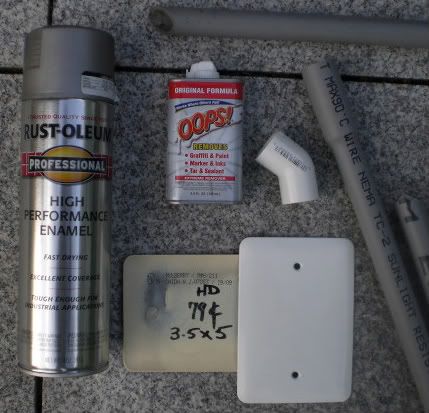
Step One: Fill the screw holes on the switch plate. Since it is a blank, the only holes are the screw holes! Sand around the holes, then I used 2 part epoxy putty. An outdoor rated sandable paintable caulk might work. Let harden then sand whole face in prep for painting.
Step 2: Spray paint top of switchplates. I set them on little flower pots to make sure that I got the edges. Let dry and give another coat. I chose Rust-oleum Professional High Performance Enamel but it left a funny powdery residue which I scrubbed off with a rag. Otherwise the stickers wouldn't have stuck. Not sure I would buy this particular paint again for this purpose. The switchplates are cheap metal, so you want to make sure you use rustoleum or another rust inhibiting paint.
Step 3: Attach elbows to backs of switchplates. Put a nice thick bead of automotive goop on one end of the elbow (a circle). Now stick it to the back of the plate where you want it (in the middle, slightly high). Now right away - Pull apart! Yup that's right. Now you have goop on both pieces. Keep separate and allow to cure for 3 to 10 minutes, then press together again. Hold tightly in place for a few seconds. Set them where they won’t be disturbed and let cure over night. I was very carefully doing 24, so when I had finished the gooping, the first ones had cured enough so I just went on and stuck them together. BTW, I measured when I did the 2 preliminary ones. When I did 24 at a time, I eyeballed it. Take your time with this part. This connection is the weak link and you want it to be done right.
Step 4: Next day, paint the back side and elbow. I set each plate on something again. When I just did two I stuffed some newspaper into the elbow so paint wouldn’t go inside, but that took too long when I was painting 24, so I put a cork into each one before I painted. Spray, let dry, spray again. If you use silver, the automotive goop seam will look like you soldered it. Now the plate part is complete (except for words, that’s tomorrows tute). Its important not to get paint inside because the elbow might not fit over the post.
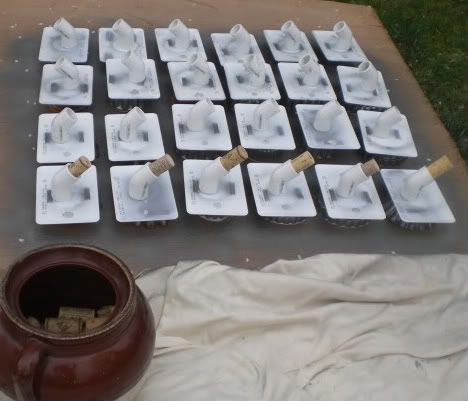
Step 5: Make the posts. Cut the pvc pipe or conduit into the lengths that you want. Remember that 4 to 6 inches or more will go into the ground. Most of them were for shrubs so we chose 2 feet. I cut 4 foot lengths then cut in half at a 45 angle to make a slightly pointy end that will go more easily into the ground. I also did some 1 footers, for the strawberries. The problem with the electrical conduit is it has a funny wide thing at the top, so there may be some waste, but at $0.82 for 10 feet, its ok. Once cut, I held the pointy end in my hand and wiped the black letters of the pipe with Oops. The pointy end will go underground so no need to wipe it off. (BTW: Neither paint thinner nor nail polish remover worked.) The first ones that I made were regular pvc pipe that I painted. But paint interferes with how the elbow fits and you have to be careful. I just didn’t have time to be careful. But for home I may make some brown ones.
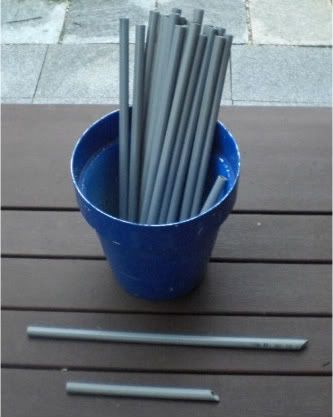
Installation: (Normally after the letters are applied). Pound a piece of rebar into the ground, for my 2 foot posts, I used 2 foot rebar. For the 1 foot post, 1 foot rebar. I used a small sledge hammer, tho a regular hammer will work. I tried to pound the rebar half way, but it didn't always work, so in some cases it "fills" the post. Pound the post over it to the height you want. Carefully push and twist the elbow onto the installed post. Hold the elbow not the switch plate!!! The elbow to switchplate seam is the weak link. Do not pound on the switchplate.
It was pouring rain when I put them in. I will probably go back and add a bit of GE silicone II for windows and doors, clear to the seam where the elbow and post overlap. Just as a precaution.
The switchplate is at a nice readable 45 degree angle. And water will run off it.
By the way, they still were not "cheap". I estimate that they cost $4.00 each plus labor. So to make them for the shelter cost a bit over $100.
Come back tomorrow and I’ll tell you how I made the words, as well as some other options.
Thanks so much for visiting. Please leave a comment so I know you have been here. And absolutely let me know if you try this, and if you make any improvements or interesting variations.
Have fun!
Kathy
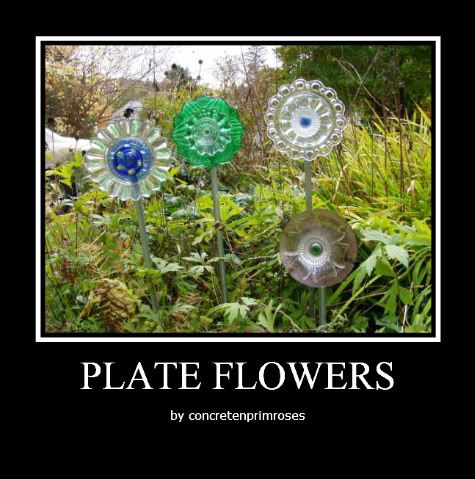
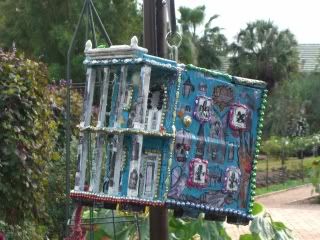





Wow! I'm in awe! I've wanted some pretty signage for my gardens. I've seen stamped silverware, but this is the bomb! I'll be back for part two!
ReplyDeleteCCPR (Kathy),
ReplyDeleteWOW! Those are absolutely wonderful! Looks like something found at an arborateum, zoo, or preserve--real professional quality. I have tags from plants that I just stick in the ground but find they disintegrate quickly. I sometimes need to get the name of a plant quick and cannot remember and don't want to get on my hands and knees to dig around to find it....this seems like a better solution although for a bigger garden for sure....BUT, I'm thinking I may steal your idea. :-) Your tutorial is great. Look forward to tutorial #2.
Love, Jules (aka Desert Rat over at Garden Junk).
I have seen how remarkably creative our human brain works. Imagine using plumbing supplies makes a lovely piece of art.
ReplyDeleteEs increible la capacidad que tienes para inventar cosas!!!! Que maravilla!!!!
ReplyDeleteMe encanta tu blog!!! Todo lo relacionado con las plantas me vuelve loca!!!
Voy a ver que más consejillos tienes por aqui!!!
Un beso, y me alegro mucho que estudies español!!!!
Kathy, this tutorial is really wonderful. These look so professional and they are! Because you are indeed a professional when it comes to making things look great. Beautiful job!
ReplyDeletethanks for the tutorial for the awesome idea!
ReplyDeletekudzu
So neat palnt labels !!!!
ReplyDeleteAnd so nice other project there in that link :)
Have a nice weekend !!!
I love this! Such a creative use of materials. Thanks so much for linking up to Finished for Friday and have a great weekend!
ReplyDeleteI really like them. Very nice!
ReplyDeleteThank you so much for taking the time to post this.I am definitely going to make these and use them in my flower beds. Where did you find your little history lessons to go with the plant names?
ReplyDeleteThank you all for commenting!
ReplyDeleteI looked up the plants on the internet. Usually googled the name of the plant followed by the word history. There were a couple of sites that had lots of the plants but not all. It was fun, but difficult, to choose which things to say. I made 4 blueberry signs so each one is a bit different.
Kathy
Hello Kathy- im going to give it all a try- when i go into work tomorrow- im going to bring a bit of every suggestion with me-and see what might look best- what is luan?
ReplyDeleteim a new follower also- Karryann
What a wonderful idea & tutorial! Yhanks so much for your time & effort to do this!
ReplyDeleteGenius. Sending a link to my mom! Visiting from Stories of a House
ReplyDeleteHow are these holding up 18 months later?
ReplyDeleteHow are these holding up 18 months later?
ReplyDelete